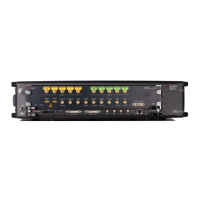Import segment data from a file. Different file formats are supported. An already
existing segment can be filled, or a new segment can be created. This can be used to
import real waveform data as well complex I/Q data.
<segment_id>: This is the number of the segment, into which the data will
be written. The range is 1...512k for option SEQ, 1 if not installed.
<file_name>: This is the complete path of the file.
TXT|TXT14|BIN|IQBIN|BIN6030|BIN5110|LICensed|MAT89600|DSA90000|CS
V: Selects the file type (See File Type).
<data_type: This parameter is only used, if the file contains complex I/Q
data. It selects, if the I values or the Q values are imported.
IONLy: Import I values.
QONLy: Import Q values.
BOTH: Import I and Q values and up-convert them to the carrier
frequency set by the CARR:FREQ command.
<marker_flag>: This flag is applicable to BIN5110 format only, which can
either consists of full 16 bit DAC values without markers or 14 bit DAC
values and marker bits in the 2 LSBs.
ON|1: The imported data will be interpreted as 14 bit DAC values
and marker bits in the 2 LSBs.
OFF|0: The imported data will be interpreted as 16 bit DAC values
without marker bits.
<padding>: This parameter is optional and specifies the padding type.
ALENgth: Automatically determine the required length of the
segment. If the segment does not exist, it is created. After
execution the segment has exactly the length of the pattern in file
or a multiple of this length to fulfill granularity and minimum
segment length requirements. This is the default behavior.
FILL: The segment must exist, otherwise an error is returned. If the
pattern in the file is larger than the defined segment length,
excessive samples are ignored. If the pattern in the file is smaller
than the defined segment length, remaining samples are filled
with the value specified by the <init_value|> and
<init_valueQ>parameter.
<init_valueI> – This is an optional initialization value used when FILL is
selected as padding type. For non-I/Q format this is a DAC value. For I/Q
file format this is the I-part of an I/Q sample pair in binary format (int16).
Defaults to 0 if not specified.
<init_valueQ> – This is an optional initialization value used when FILL is
selected as padding type. Is is only applicable for I/Q file formats. This is the
Q-part of an I/Q sample pair in binary format (int16). Defaults to 0 if not
specified.
<ignore_header_parameters>: This flag is optional and used to specify if the
header parameters from the file need to be set in the instrument or ignored.
This flag is applicable to formats CSV and MAT89600, which can contain
header parameters.
ON|1: Header parameters will be ignored.
OFF|0: Header parameters will be set. This is the default.

